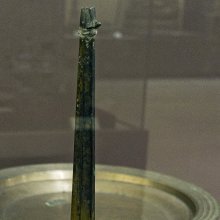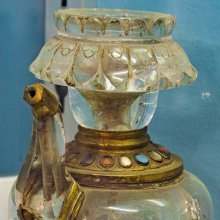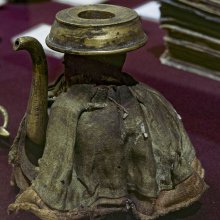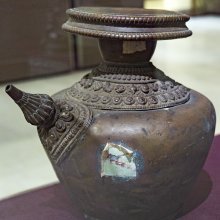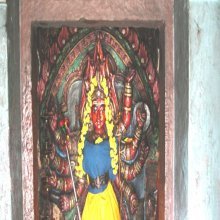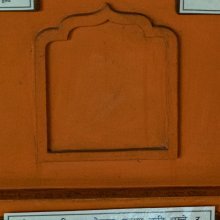Kalasha, Kalaśa, Kalasa: 40 definitions
Introduction:
Kalasha means something in Buddhism, Pali, Hinduism, Sanskrit, Jainism, Prakrit, the history of ancient India, Marathi, Hindi, biology. If you want to know the exact meaning, history, etymology or English translation of this term then check out the descriptions on this page. Add your comment or reference to a book if you want to contribute to this summary article.
The Sanskrit term Kalaśa can be transliterated into English as Kalasa or Kalasha, using the IAST transliteration scheme (?).
Alternative spellings of this word include Kalash.
Images (photo gallery)
(+10 more images available)
In Hinduism
Shilpashastra (iconography)
Source: Wisdom Library: Śilpa-śāstraKalaśa (कलश, “pot”) refers to the ‘vase-finial’; it is an alternative name for a stūpī. Kalaśa can also refer to the Nāgara equivalent of kumuda, cushion moulding in plinth.
Source: Red Zambala: Hindu Icons and Symbols | IntroductionKalaśa (Vase) - receptacle of water which is the foremost representative of life in general, water is also allied to breath and all-pervading cosmic consciousness. The heart of the devotee should be ready like the jar to contain and hold the waters of truth and universal wellbeing. The jar also contains the nectar of immortality — liberation from conditioned existence.
Source: Shodhganga: The significance of the mūla-beras (śilpa)1) Kalaśa (कलश) refers to an “ornamental pot” found in finials and capitals.—The prāsāda (a three-storeyed palace) is almost completely a solid mass on whose multi-buttressed walls the images are displayed. The finial/the culminating portion of a pinnacle is raised above the body of the prāsāda as it is on the crown of the temple known as āmalaka (dome). It is a ribbed flattened top surmounted by a kalaśa (ornamental pot found in finials and capitals), topped by a finial and a banner. It is also known as harmya (a beautiful palace) in South Indian temples.
2) Kalasa (“pot”) refers to one of the several “attributes” (āyudha) or “accessories” of a detiy commonly seen depicted in Hindu iconography, defined according to texts dealing with śilpa (arts and crafs), known as śilpaśāstras.—The śilpa texts have classified the various accessories under the broad heading of āyudha or karuvi (implement), including even flowers, animals, and musical instruments. The other miscellaneous articles found as attributes in the hands of the deities are, for example, Kalasa.

Shilpashastra (शिल्पशास्त्र, śilpaśāstra) represents the ancient Indian science (shastra) of creative arts (shilpa) such as sculpture, iconography and painting. Closely related to Vastushastra (architecture), they often share the same literature.
Vastushastra (architecture)
Source: Wisdom Library: Vāstu-śāstraKalaśa (कलश):—The Sanskrit name for a classification of a ‘temple’, according to the Agnipurāṇa, featuring a list of 45 temple types. It is listed under the group named Kailāśa, featuring circular-shaped temples. This list represents the classification of temples in North-India.
Source: OpenEdition books: Architectural terms contained in Ajitāgama and RauravāgamaKalaśa (कलश) refers to “capital § 3.19.”.—(For paragraphs cf. Les enseignements architecturaux de l'Ajitāgama et du Rauravāgama by Bruno Dagens)

Vastushastra (वास्तुशास्त्र, vāstuśāstra) refers to the ancient Indian science (shastra) of architecture (vastu), dealing with topics such architecture, sculpture, town-building, fort building and various other constructions. Vastu also deals with the philosophy of the architectural relation with the cosmic universe.
Purana and Itihasa (epic history)
Source: archive.org: Puranic EncyclopediaKalaśa (कलश).—A serpent born of the family of Kaśyapa. (Śloka 11, Chapter 103, Udyoga Parva).
Source: archive.org: Shiva Purana - English TranslationKalaśa (कलश) refers to “(gold) pots” (for decoration), according to the Śivapurāṇa 2.3.41 (“Description of the Altar-Structure”).—Accordingly, as Brahmā narrated to Nārada: “[...] O great sage, tired of seeing the portrayal of yourself, you became engaged in seeing the other builds of Viśvakarman. You entered the great altar of Himavat, studded with various gems and decorated with gold pots (suvarṇa-kalaśa) and stumps of plantain trees. It had a thousand columns. It was wonderful. O sage, you were struck with surprise on seeing the altars. [...]”.
Source: Cologne Digital Sanskrit Dictionaries: The Purana IndexKalaśa (कलश).—A Rākṣasa; his city in the Atalam.*
- * Vāyu-purāṇa 50. 18.
Kalaśa (कलश) is a name mentioned in the Mahābhārata (cf. V.101.11/V.103) and represents one of the many proper names used for people and places. Note: The Mahābhārata (mentioning Kalaśa) is a Sanskrit epic poem consisting of 100,000 ślokas (metrical verses) and is over 2000 years old.

The Purana (पुराण, purāṇas) refers to Sanskrit literature preserving ancient India’s vast cultural history, including historical legends, religious ceremonies, various arts and sciences. The eighteen mahapuranas total over 400,000 shlokas (metrical couplets) and date to at least several centuries BCE.
Chandas (prosody, study of Sanskrit metres)
Source: Shodhganga: a concise history of Sanskrit Chanda literatureKalaśa (कलश) is the son of king Ananta and one of the patrons of Kṣemendra, who, (as a poet, as a historian and as a rhetorician) was patronized by many kings of Kashmir of his time. Mainly king Ananta and his son Kalaśa had extended patronage to the great composer. In his Aucityavicāracarcā, Kṣemendra also mentions about Ratnasiṃha and Udayasiṃha as his patrons.

Chandas (छन्दस्) refers to Sanskrit prosody and represents one of the six Vedangas (auxiliary disciplines belonging to the study of the Vedas). The science of prosody (chandas-shastra) focusses on the study of the poetic meters such as the commonly known twenty-six metres mentioned by Pingalas.
Ayurveda (science of life)
Kalpa (Formulas, Drug prescriptions and other Medicinal preparations)
Source: Shodhganga: Edition translation and critical study of yogasarasamgrahaKalaśa (कलश) is another name for Āḍhaka: a unit of measurement of weight (1 kalaśa equals 3.072kg; 4 kalaśas = 1 droṇa = 12.288kg), as defined in the 15th-century Yogasārasaṅgraha (Yogasara-saṅgraha) by Vāsudeva: an unpublished Keralite work representing an Ayurvedic compendium of medicinal recipes. The Yogasārasaṃgraha [mentioning kalaśa] deals with entire recipes in the route of administration, and thus deals with the knowledge of pharmacy (bhaiṣajya-kalpanā) which is a branch of pharmacology (dravyaguṇa).
A relative overview of weight-units is found below, kalaśa/āḍhaka indicated in bold. In case of liquids, the metric equivalents would be the corresponding litre and milliliters.
1 Ratti or Guñjā = 125mg,
8 Rattis - 1 Māṣa = 1g,
4 Māṣa - 1 Kaḻañc = 4g,
12 Māṣas - 1 Karṣa = 12g,
1 Karṣa /Akṣa - 1 Niṣka = 12g,
2 Karṣas - 1 Śukti = 24g,
2 Śukti - 1 Pala = 48g,
2 Palas - 1 Prasṛti = 96g,
2 Prasṛtis - 1 Kuḍava = 192g,
2 Kuḍava - 1 Mānikā = 384g,
2 Mānikās - 1 Prastha (Seru) = 768g,
4 Prasthas - 1 Āḍhaka (Kaṃsa) = 3.072kg,
4 Āḍhakas or Kalaśas - 1 Droṇa = 12.288kg,
2 Droṇas - 1 Surpa = 24.576kg,
2 Surpas - 1 Droṇī (Vahi) = 49.152kg,
4 Droṇīs - 1 Khari = 196.608kg,
1 Pala = 48g,
100 Palas - 1 Tulā = 4.8kg,
20 Tulās - 1 Bhāra = 96kg.
Unclassified Ayurveda definitions
Source: gurumukhi.ru: Ayurveda glossary of termsKalaśa (कलश):—A unit of Measurement; Synonym of one drona = 12. 288 kg / l of metric units

Āyurveda (आयुर्वेद, ayurveda) is a branch of Indian science dealing with medicine, herbalism, taxology, anatomy, surgery, alchemy and related topics. Traditional practice of Āyurveda in ancient India dates back to at least the first millenium BC. Literature is commonly written in Sanskrit using various poetic metres.
Jyotisha (astronomy and astrology)
Source: Google Books: Studies in the History of the Exact Sciences (Astronomy)Kalaśa (कलश) refers to a “pot”, according to Lalla’s Śiṣyadhīvṛddhidatantra (Part I, 21, Yantrādhikāra, 34-35).—(Cf. Astronomical instruments in Bhāskarācārya’s Siddhāntaśiromaṇi).—Accordingly, “The bowl, which resembles half a pot [i.e., kalaśa-ardha] (i.e. hemispherical), which is made of ten palas of copper, which is half a cubit (i.e. twelve aṅgulas) in diameter at the mouth and half (i.e. six aṅgulas) as high, which is evenly circular, and which is bored by a uniformly circular needle, made of three and one-third māṣas of gold and of four aṅgulas in length, sinks into clear water in one ghaṭikā (nāḍī)”.

Jyotisha (ज्योतिष, jyotiṣa or jyotish) refers to ‘astronomy’ or “Vedic astrology” and represents the fifth of the six Vedangas (additional sciences to be studied along with the Vedas). Jyotisha concerns itself with the study and prediction of the movements of celestial bodies, in order to calculate the auspicious time for rituals and ceremonies.
Shaivism (Shaiva philosophy)
Source: Brill: Śaivism and the Tantric TraditionsKalaśa (कलश) refers to a “pot (for storing water used in consecration rituals)”, as quoted by Hṛdayaśiva in his Prāyaścittasamuccaya (verse 10.27-35).—Accordingly, “[...] The Mantrin, intent on attaining all manner of special powers, should perform the observance for the pāśupatāstra resolutely dressed in multi-coloured garments and with multi-coloured garlands and unguents. And upon the completion of one or another of these observances, he should pour upon himself Śiva-water that has been consecrated by recitation of his mantra over it from a pot (kalaśa). [...]”.
Source: SOAS University of London: Protective Rites in the Netra TantraKalaśa (कलश) refers to a “water pot”, according to the Netratantra of Kṣemarāja: a Śaiva text from the 9th century in which Śiva (Bhairava) teaches Pārvatī topics such as metaphysics, cosmology, and soteriology.—Accordingly, [verse 3.17-23, while describing a meditation on Amṛteśa in his form as Mṛtyujit]—“And so now, having constructed the amṛtāmudrā or the padmamudrā, [the Mantrin] should meditate on the Ātman. [...] [He is] one-faced, three-eyed, seated on a white lotus, fixed in the bound lotus seat. [He is] four-armed, large-eyed, the hand [fixed in the position] of granting wishes and safety, [holding] a full moon, radiant, filled with amṛta, holding a water pot (kalaśa—kalaśaṃ dhārayantaṃ hi), [and] completely full of the world, the moon in his lovely hand. [The Mantrin] should remember him adorned with a reverence that is all white”.

Shaiva (शैव, śaiva) or Shaivism (śaivism) represents a tradition of Hinduism worshiping Shiva as the supreme being. Closely related to Shaktism, Shaiva literature includes a range of scriptures, including Tantras, while the root of this tradition may be traced back to the ancient Vedas.
In Buddhism
Tibetan Buddhism (Vajrayana or tantric Buddhism)
Source: OSU Press: Cakrasamvara SamadhiKalaśa (कलश) refers to the “ritual flask called the kalaśa”, according to Buddhist teachings followed by the Newah in Nepal, Kathmandu Valley (whose roots can be traced to the Licchavi period, 300-879 CE).—Kalaśapūjā, “Kalaśa worship”, is the worship of a the ritual flask called the kalaśa, which is imagined to symbolize the body, which receives the samayasattva, “vow being”, which is the visualized deity, and the jñānasattva, “knowledge being”, which is the deities essence. The kalaśapūjā also includes the nirāñjana, which figuratively means “removing darkness” and involves burning fragrant scents in a clay pot and reciting mantras to purify the worshiper.

Tibetan Buddhism includes schools such as Nyingma, Kadampa, Kagyu and Gelug. Their primary canon of literature is divided in two broad categories: The Kangyur, which consists of Buddha’s words, and the Tengyur, which includes commentaries from various sources. Esotericism and tantra techniques (vajrayāna) are collected indepently.
In Jainism
General definition (in Jainism)
Source: archive.org: TrisastisalakapurusacaritraKalaśa (कलश) refers to the “pitcher” and represents one of the “eight auspicious thins” in Jainism, according to chapter 1.2 [ādīśvara-caritra] of Hemacandra’s 11th century Triṣaṣṭiśalākāpuruṣacaritra: an ancient Sanskrit epic poem narrating the history and legends of sixty-three illustrious persons in Jainism.
Accordingly:
Source: Shodhganga: A cultural study on the jain western Indian illustrated manuscripts“[...] Then, after circumambulating it, he ascended his aerial car, like his own lofty pride, by the east steps. [...] Then Śakra’s Śāmānikas, like other forms of Śakra, ascended by the north steps and took their proper seats. [...] In front of the Lord of Paulomī (Śakra) seated on the lion-throne shone eight groups of the eight auspicious things, [viz., kalaśa], etc. [...]”.
Kalaśa (कलश, “vessel”).—One of the eight providential symbols, or, aṣṭamaṅgala.—Kalaśa represents the three worlds and Jineśvara’s own ancestors.

Jainism is an Indian religion of Dharma whose doctrine revolves around harmlessness (ahimsa) towards every living being. The two major branches (Digambara and Svetambara) of Jainism stimulate self-control (or, shramana, ‘self-reliance’) and spiritual development through a path of peace for the soul to progess to the ultimate goal.
India history and geography
Source: Cologne Digital Sanskrit Dictionaries: Indian Epigraphical GlossaryKalasa.—(CITD), a vase, flagon or water-pot; an orna- mental piece of painted wood, stone, brass, etc., fixed on the spires of temples, carts, etc.; a rounded pinnacle or ball on the top of a temple; a dome. (EI 5), the pinnacle of a temple; same as kumbha. (EI 11, 33), a measure; cf. droṇa. (SII 3), a pot. (EI 33), also called kalasikā; probably, the same as droṇa; a measure of capacity. Note: kalasa is defined in the “Indian epigraphical glossary” as it can be found on ancient inscriptions commonly written in Sanskrit, Prakrit or Dravidian languages.
Source: Yale Journal of Music & Religion: Ritual Music in Contemporary Brahmanical Tantric Temples of KeralaKalaśa (कलश) refers to the “main pot” (filled with water, etc.) used during the Brahmakalaśa ritual during the Yearly Festivals (utsava) of Kerala temples.—The very core of the festival is Brahma-kalaśa. This ritual, a magnified version of the daily invocation (āvāhana), essentially consists of the filling of pots with water and other materials, sanctifying them with mantras of the cosmic principles (tattvas) and pouring their contents over the idol. Brahma-kalaśa indicates, at the same time, the ritual that may involve up to 1,000 pots, including the main pot (kalaśa), which is brought to the śrīkōvil in royal procession, since it represents the main deity of the temple. All the stages of this ritual are supported by music.

The history of India traces the identification of countries, villages, towns and other regions of India, as well as mythology, zoology, royal dynasties, rulers, tribes, local festivities and traditions and regional languages. Ancient India enjoyed religious freedom and encourages the path of Dharma, a concept common to Buddhism, Hinduism, and Jainism.
Biology (plants and animals)
Source: Wisdom Library: Local Names of Plants and DrugsKalasa in the Telugu language is the name of a plant identified with Leptadenia reticulata (Retz.) Wight & Arn. from the Apocynaceae (Oleander) family having the following synonyms: Cynanchum reticulatum. For the possible medicinal usage of kalasa, you can check this page for potential sources and references, although be aware that any some or none of the side-effects may not be mentioned here, wether they be harmful or beneficial to health.
Kalasa in the Telugu language is the name of a plant identified with Corchorus aestuans L. from the Tiliaceae (Phalsa) family having the following synonyms: Corchorus acutangulus.
Source: Google Books: CRC World Dictionary (Regional names)1) Kalasa in India is the name of a plant defined with Corchorus olitorius in various botanical sources. This page contains potential references in Ayurveda, modern medicine, and other folk traditions or local practices.
2) Kalasa is also identified with Corchorus aestuans It has the synonym Triumfetta bogotensis DC. (etc.).
3) Kalasa is also identified with Leptadenia reticulata It has the synonym Cynanchum reticulatum Retz. (etc.).
4) Kalasa in Tanzania is also identified with Bidens pilosa It has the synonym Myriogyne minuta (G. Forst.) Less. (etc.).
Example references for further research on medicinal uses or toxicity (see latin names for full list):
· Meth. (1794)
· Adansonia (1978)
· African Journal of Traditional, Complimentary and Alternative Medicines (2007)
· Taxon (1981)
· Proceedings of a Workshop on African Indigenous Vegetables (1997)
· A Manual Flora of Madeira (1860)
If you are looking for specific details regarding Kalasa, for example extract dosage, pregnancy safety, side effects, diet and recipes, health benefits, chemical composition, have a look at these references.

This sections includes definitions from the five kingdoms of living things: Animals, Plants, Fungi, Protists and Monera. It will include both the official binomial nomenclature (scientific names usually in Latin) as well as regional spellings and variants.
Languages of India and abroad
Pali-English dictionary
Source: BuddhaSasana: Concise Pali-English Dictionarykalasa : (nt.) a small water-pot.
Source: Sutta: The Pali Text Society's Pali-English DictionaryKalasa, (nt.) (cp. Vedic kalaśa) 1. a pot, waterpot, dish, jar M. III, 141; J. IV, 384; Dāvs. IV, 49; PvA. 162.—2. the female breasts (likened to a jar) Mhbv 2, 22. (Page 198)

Pali is the language of the Tipiṭaka, which is the sacred canon of Theravāda Buddhism and contains much of the Buddha’s speech. Closeley related to Sanskrit, both languages are used interchangeably between religions.
Marathi-English dictionary
Source: DDSA: The Molesworth Marathi and English Dictionarykalaśa (कलश).—m (S) A water-vessel, whether of metal or earth.
--- OR ---
kaḷasa (कळस).—m (kalaśa S) An ornamental piece of paint- ed wood &c. as fixed on the spires of temples, on tent-poles, corners of a roof &c. Applied also to a dome or cupola. Ex. rājamaṇḍaḷācē ḍhaḷalē ka0 || 2 fig. Pinnacle, vertex, acme (as of greatness or of any particular virtue or vice): also the conclusion or terminating point (of a business). 3 fig. The spire of the neck, i. e. the head; as in the phrase mānēcā ka0 ḍhaḷaṇēṃ g. of s. To be on the point of death. 4 (For kalaśa) A water vessel (metal or earthen).
--- OR ---
kaḷasā (कळसा).—m C (kalaśa S) An earthen water-vessel with a spout. 2 R A metal water vessel. 3 The mass of kneaded earth (at a pottery) from which the pots are formed.
--- OR ---
kaḷasa (कळस).—. Add:--kaḷasa hōṇēṃ g. of s. To attain its acme or culminating point. Used freely. Ex. nēmācā jhālā kaḷasa || kāsayā vyartha uphaṇūṃ bhūsa || lēkhaṇī na dharī ||.
Source: DDSA: The Aryabhusan school dictionary, Marathi-Englishkalaśa (कलश).—m A water vessel.
--- OR ---
kaḷasa (कळस).—m A dome. Pinnacle (of greatness &c.). A water vessel. kaḷasa hōṃṇēṃ Things have reached a crisis; to culminate.
Marathi is an Indo-European language having over 70 million native speakers people in (predominantly) Maharashtra India. Marathi, like many other Indo-Aryan languages, evolved from early forms of Prakrit, which itself is a subset of Sanskrit, one of the most ancient languages of the world.
Sanskrit dictionary
Source: DDSA: The practical Sanskrit-English dictionaryKalaśa (कलश).—[kena jalena laśa-sa-ti Tv.]
1) A pitcher, water-pot, a jar, dish; हिरण्मयं कलशं विभर्षि (hiraṇmayaṃ kalaśaṃ vibharṣi) Mahābhārata on P.VI.4.174; Śiśupālavadha 11; स्तनौ मांसग्रन्थी कनककलशा- वित्युपमितौ (stanau māṃsagranthī kanakakalaśā- vityupamitau) Bhartṛhari 3.2,1.97; Amaru 54. °जन्मन्, °उद्भवः (janman, °udbhavaḥ) Name of Agastya.
2) A churn.
3) A kind of measure.
4) A rounded pinnacle on the top of a temple
5) The ocean; क्षोभ्यतां कलशः सर्वैर्मन्दरः परिवर्त्यताम् (kṣobhyatāṃ kalaśaḥ sarvairmandaraḥ parivartyatām) Mahābhārata (Bombay) 1.18.32.
Derivable forms: kalaśaḥ (कलशः), kalaśam (कलशम्).
See also (synonyms): kalasa.
Source: Cologne Digital Sanskrit Dictionaries: Shabda-Sagara Sanskrit-English DictionaryKalaśa (कलश).—mfn.
(-śaḥ-śī-śaṃ) An earthen water-pot; also kalasa, kalaśi, &c. E. ka water, laś to labour, ka aff.
--- OR ---
Kalasa (कलस).—mfn.
(-saḥ-sī-saṃ) A water-jar: see kalaśa. m.
(-saḥ) 1. A measure, a Drona: see droṇa. 2. A rounded pinnacle or ball on the top of a temple. f. (-sī) A plant: see kalaśi, &c.
Source: Cologne Digital Sanskrit Dictionaries: Benfey Sanskrit-English DictionaryKalaśa (कलश).—or kalasa kalasa, I. m. (and f. śī, and n.), A water-pot, a cup, [Pañcatantra] 252, 10; i. [distich] 225; designation of the ocean when churned, Mahābhārata 1, 1149. Ii. f. śī, 1. A plant, Hemionitis cordifolia, Roxb., [Suśruta] 1, 139, 15. 2. The name of a holy place, Mahābhārata 3, 650.
Source: Cologne Digital Sanskrit Dictionaries: Cappeller Sanskrit-English DictionaryKalaśa (कलश).—[masculine] ī [feminine] pot, water-jar (adj. —° [feminine] ī).
--- OR ---
Kalasa (कलस).—v. kalaśa.
Source: Cologne Digital Sanskrit Dictionaries: Aufrecht Catalogus Catalogorum1) Kalaśa (कलश) as mentioned in Aufrecht’s Catalogus Catalogorum:—poet. Śp. p. 14. [Subhāshitāvali by Vallabhadeva] Quoted by Kṣemendra in Suvṛttatilaka 2, 14.
2) Kalaśa (कलश):—vaid. Rādh. 2.
3) Kalaśa (कलश):—vaid. Oudh. Xx, 8. Xxii, 44.
Source: Cologne Digital Sanskrit Dictionaries: Monier-Williams Sanskrit-English Dictionary1) Kalaśa (कलश):—m. (n., [cf. Lexicographers, esp. such as amarasiṃha, halāyudha, hemacandra, etc.]) a water-pot, pitcher, jar, dish, [Ṛg-veda] etc., [Śakuntalā; Hitopadeśa] etc. (the breasts of a woman are frequently compared to jars cf. stana-k and kumbha)
2) m. a butter-tub, churn, [Mahābhārata]
3) a particular measure (= droṇa), [Śārṅgadhara-saṃhitā]
4) a round pinnacle on the top of a temple ([especially] the pinnacle crowning a Buddhist Caitya or Stūpa), [Kādambarī]
5) Name of a man, [Ṛg-veda x, 32, 9]
6) of a poet
7) of a Nāga, [Mahābhārata v]
8) cf. [Greek] κάλιξ; [Latin] calix.
9) Kalasa (कलस):—[varia lectio] for kalaśa above.
Source: Cologne Digital Sanskrit Dictionaries: Yates Sanskrit-English Dictionary1) Kalaśa (कलश):—(śaḥ) 1. m. A water-pot.
2) Kalasa (कलस):—(saḥ) 1. m. A water-jar
Source: DDSA: Paia-sadda-mahannavo; a comprehensive Prakrit Hindi dictionary (S)Kalaśa (कलश) in the Sanskrit language is related to the Prakrit word: Kalasa.
[Sanskrit to German]
Sanskrit, also spelled संस्कृतम् (saṃskṛtam), is an ancient language of India commonly seen as the grandmother of the Indo-European language family (even English!). Closely allied with Prakrit and Pali, Sanskrit is more exhaustive in both grammar and terms and has the most extensive collection of literature in the world, greatly surpassing its sister-languages Greek and Latin.
Hindi dictionary
Source: DDSA: A practical Hindi-English dictionary1) Kalaśa (कलश) [Also spelled kalash]:—(nm) a pitcher, an urn; a dome, pinnacle.
2) Kalasā (कलसा) [Also spelled kalsa]:—(nm) a metal pitcher; hence [kalasī] (diminutive, nf).
...
Prakrit-English dictionary
Source: DDSA: Paia-sadda-mahannavo; a comprehensive Prakrit Hindi dictionary1) Kalasa (कलस) in the Prakrit language is related to the Sanskrit word: Kalaśa.
2) Kalasa (कलस) also relates to the Sanskrit word: Kalaśa.
Prakrit is an ancient language closely associated with both Pali and Sanskrit. Jain literature is often composed in this language or sub-dialects, such as the Agamas and their commentaries which are written in Ardhamagadhi and Maharashtri Prakrit. The earliest extant texts can be dated to as early as the 4th century BCE although core portions might be older.
Kannada-English dictionary
Source: Alar: Kannada-English corpusKalaśa (ಕಲಶ):—
1) [noun] a water jar.
2) [noun] a small water vessel with a small mouth, used in worshipping and other auspicious occasions, as asymbol of the universe (or cosmic waters) and its generative power.
3) [noun] an ornamental metal cover for the peak structure of a temple, temple-chariot, etc.
4) [noun] a person who is the pride of a society or community.
--- OR ---
Kalasa (ಕಲಸ):—[noun] = ಕಲಶ [kalasha].
--- OR ---
Kaḷaśa (ಕಳಶ):—
1) [noun] a water jar.
2) [noun] a small water vessel with a narrow mouth, used in worshipping and on other auspicious occasions, as a symbol of the universe (or Cosmic waters) and its generative power.
3) [noun] an ornamental metal cover for the peak structure of a temple, temple-chariot, etc.
4) [noun] a person who is the pride of a society or community.
5) [noun] ಕಳಶವಿಟ್ಟಂತೆ [kalashavittamte] kaḷaśaviṭṭante (fig.) like being a more distinctive accomplishment to one who is already has achieved many.
--- OR ---
Kaḷasa (ಕಳಸ):—[noun] = ಕಳಶ [kalasha].
--- OR ---
Kaḷāsa (ಕಳಾಸ):—
1) [noun] the quality of adhereing, blending with or the fact of being adhered firmly or fused with, another.
2) [noun] the quality of being intense; intensity.
3) [noun] the act of joining two things together.
4) [noun] (musc.) complete agreement; harmony, concord.
5) [noun] (dance.) a particular movement; elegance in the movement of a dancer.
--- OR ---
Kālāṣa (ಕಾಲಾಷ):—[noun] = ಕಾಲಾಪ [kalapa]1.
--- OR ---
Kāḷasa (ಕಾಳಸ):—[noun] = ಕಾಳಸೆ [kalase].
--- OR ---
Kāḷasa (ಕಾಳಸ):—[noun] the tanned hide of animals, as of deer, etc., used to sit on.
--- OR ---
Kāḷāsa (ಕಾಳಾಸ):—[noun] = ಕಾಳಸೆ [kalase].
Kannada is a Dravidian language (as opposed to the Indo-European language family) mainly spoken in the southwestern region of India.
Nepali dictionary
Source: unoes: Nepali-English DictionaryKalaśa (कलश):—n. 1. pitcher; jar; waterpot; 2. a waterpot; an auspicious symbol used in many rituals; 3. a rounded pinnacle on the top of temple; dome;
Nepali is the primary language of the Nepalese people counting almost 20 million native speakers. The country of Nepal is situated in the Himalaya mountain range to the north of India.
See also (Relevant definitions)
Starts with (+24): Kalashabandha, Kalashabara, Kalashabaratantra, Kalashabhisheka, Kalashabhu, Kalashadir, Kalashaganike, Kalashagitti, Kalashaila, Kalashaili, Kalashajanman, Kalashaka, Kalashakshetramahatmya, Kalashakti, Kalashakuca, Kalashakuce, Kalashali, Kalashambara, Kalashambhodhi, Kalashamrita.
Ends with (+16): Alakakalasha, Alamkakalasha, Amritakalasha, Bhatta muktikalasha, Bhutikalasha, Brahmakalasha, Carakalasha, Caukalasha, Devakalasha, Dronakalasha, Haimakalasha, Hemakalasha, Hirakalasha, Indukalasha, Jyeshthakalasha, Kanakakalasha, Kancanakalasha, Karakalasha, Krikalasa, Kshamakalasha.
Full-text (+228): Ratnakalasha, Kalashi, Hemakalasha, Karakalasha, Nanaratna, Kalashasthapana, Jhatiti, Antarastha, Ganeshvara, Caukalasha, Pariṇata, Manibhadra, Dhanavriddhi, Sthanadhipati, Yashasvriddhi, Gajavaktra, Kalasapaki, Vajrayaksha, Purnabhadra, Siddhiyogini.
Relevant text
Search found 61 books and stories containing Kalasha, Kalaśa, Kalasa, Kaḷasa, Kaḷasā, Kalasā, Kalāsa, Kaḷaśa, Kaḷāsa, Kālāṣa, Kāḷasa, Kāḷāsa; (plurals include: Kalashas, Kalaśas, Kalasas, Kaḷasas, Kaḷasās, Kalasās, Kalāsas, Kaḷaśas, Kaḷāsas, Kālāṣas, Kāḷasas, Kāḷāsas). You can also click to the full overview containing English textual excerpts. Below are direct links for the most relevant articles:
Rig Veda (translation and commentary) (by H. H. Wilson)
Gati in Theory and Practice (by Dr. Sujatha Mohan)
Technical treatises on Nāṭya (other works) < [Chapter 1 - Nāṭya]
Observations on works on nāṭya in Sanskrit literature < [Chapter 1 - Nāṭya]
Observations and findings on the practice of Gati < [Chapter 4 - Practice of Gati]
Temples of Munnur (Historical Study) (by R. Muthuraman)
Sri Prakannayagi Amman Shrine < [Chapter 4]
Vishveswarar Sub-shrine < [Chapter 4]
Sri Kamatchi Amman Shrine < [Chapter 4]
Charaka Samhita (English translation) (by Shree Gulabkunverba Ayurvedic Society)
Chapter 12c - Table of Measures (mana) < [Kalpasthana (Kalpa Sthana) — Section on Pharmaceutics]
Jain Remains of Ancient Bengal (by Shubha Majumder)
Jain Caumukha/Caumukhi or Caturmukhas < [Chapter 6 - Iconographic Study of Jaina Sculptural Remains]
The twenty-four Tīrthaṅkaras and their Yakṣas and Yakṣiṇīs < [Chapter 6 - Iconographic Study of Jaina Sculptural Remains]
Images of Tīrthaṅkara Mallinātha < [Chapter 6 - Iconographic Study of Jaina Sculptural Remains]
Dance Traditions of South India < [January-February 1935]
Chitrasalas- Ancient Indian Art Galleries < [September-October 1934]
Kathakali, and Other Forms of Bharata Natya < [September-October 1933]
Related products
